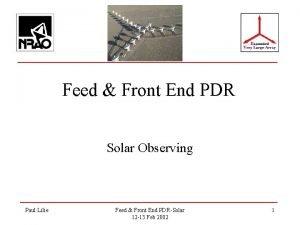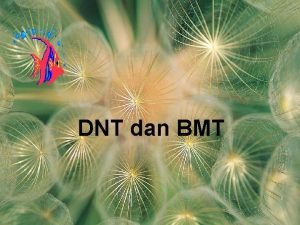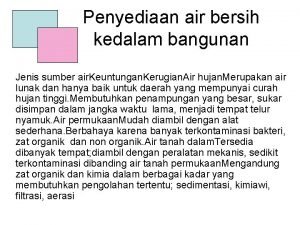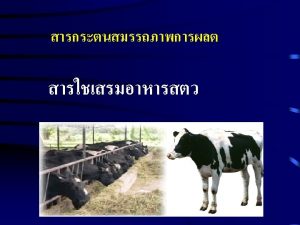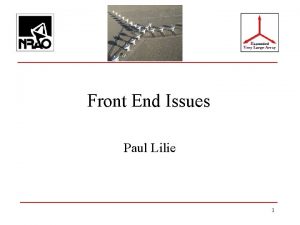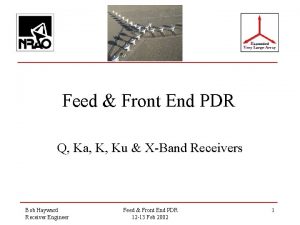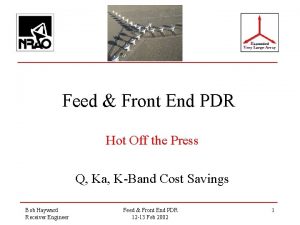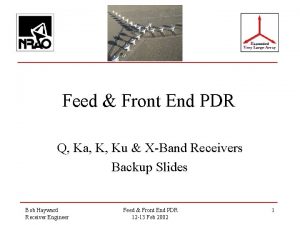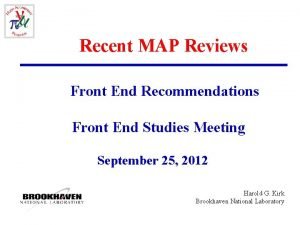Feed Front End PDR System Requirements Paul Lilie










- Slides: 10

Feed & Front End PDR System Requirements Paul Lilie Feed & Front End PDR—Sys. Reqts 12 – 13 Feb. 2002 1

On-Axis Efficiency – Band – 1. 2 -2 – 2 -4 – 4 -8, 8 -12, 12 -18 – 18 -26 – 26 -40 – 40 -50 Paul Lilie Req’d. 50. 55. 60. 55. 50. 45 -. 40 Feed & Front End PDR—Sys. Reqts 12 – 13 Feb. 2002 Target. 55. 60. 65. 60. 55. 50 -. 45 2

System Temperatures – – – – – Paul Lilie Band 1 -2 2 -4 4 -8 8 -12 12 -18 18 -26 26 -40 40 -50 Trx 9 11 16 21 22 28 38 45 Tsys* 20 25 31 34 35 52 56 76 - 104 * Above atmosphere Feed & Front End PDR—Sys. Reqts 12 – 13 Feb. 2002 3

Polarization • Circular polarization will be used. • On-axis voltage axial ratios better than 0. 9 – (ellipticity better than 0. 92 d. B) • On-axis LCP & RCP major axes orthogonal within 10° • All antennas same within above tolerances. • Change in axial ratio < 0. 002 over 8 hour period. • Change in position angle < 2° over 8 hour period. Paul Lilie Feed & Front End PDR—Sys. Reqts 12 – 13 Feb. 2002 4

Beam • Beam illumination: – Illumination centroid to be within 10 cm of the antenna center. • Beam Similarity: – Power gain variations between antennas to vary less than 1% of the peak, within the inner 6 d. B of the primary beam. Paul Lilie Feed & Front End PDR—Sys. Reqts 12 – 13 Feb. 2002 5

Beam Similarity (phase) • Phase variations between antennas to vary, within 3 d. B beamwidth: – 1 -2 GHz: – 2 -4 GHz: – 4 -8 GHz: – other bands: Paul Lilie < 0. 2 degree < 0. 5 degree < 1. 0 degree < 5 degrees Feed & Front End PDR—Sys. Reqts 12 – 13 Feb. 2002 6

Gain Linearity • Better than 0. 5% over 15 d. B range. • 1 to 2% over “solar” range. Paul Lilie Feed & Front End PDR—Sys. Reqts 12 – 13 Feb. 2002 7

Delay • Variations < 0. 5 ps, up to one second. • Mean slope < 0. 2 ps per minute, up to ½ hour – Deviation from mean slope < 1. 4 ps • Max change 0. 7 ps for change < 10°in antenna position. – < 0. 07 ps change per degree change in antenna position, for elevations < 60 degrees Paul Lilie Feed & Front End PDR—Sys. Reqts 12 – 13 Feb. 2002 8

Bandpass Characteristics • Power bandpass varies <. 01% per hour, for frequency ranges up to RF/1000 • Phase variations <0. 01° per 1 hour for frequency ranges up to RF/1000 • Power gain slope < 3 d. B over full bandwidth. Paul Lilie Feed & Front End PDR—Sys. Reqts 12 – 13 Feb. 2002 9

Bandpass Characteristics Bandpass slope < 0. 3 d. B Bandpass ripple <0. 25 d. B p-p Phase variations < 2 degrees rms For frequency ranges smaller than: 0. 5 MHz in 1 -2 GHz 1 MHz in 2 -4 GHz 2 MHz in 4 -8 and 8 -12 4 MHz in other bands. Paul Lilie Feed & Front End PDR—Sys. Reqts 12 – 13 Feb. 2002 10



